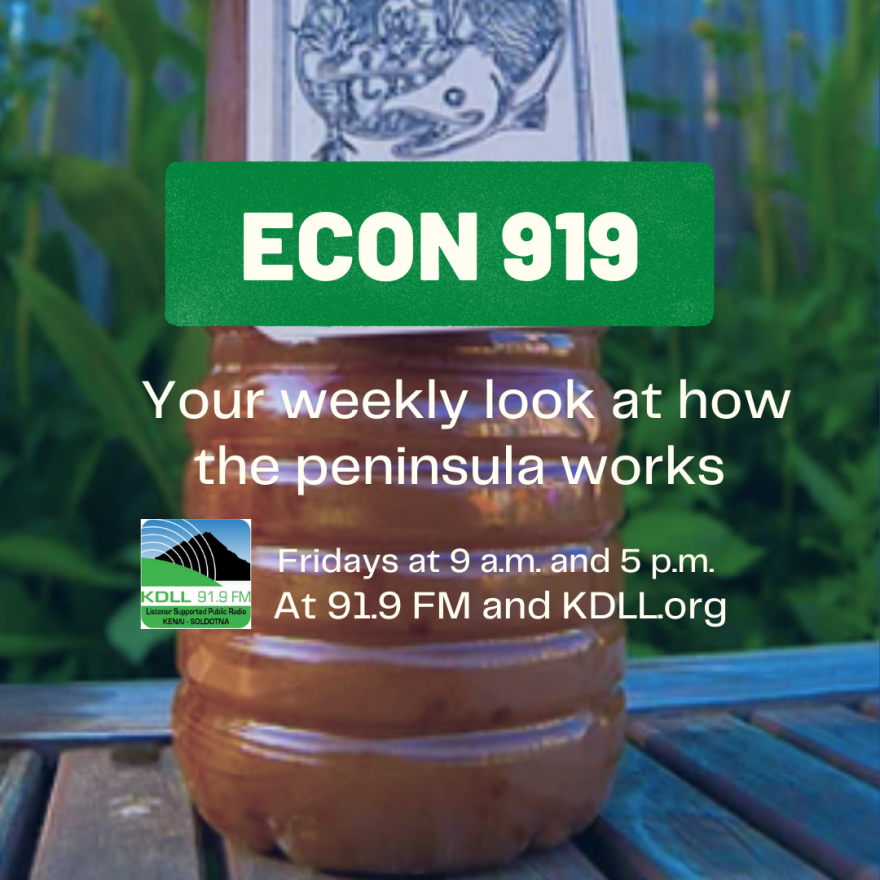Earth Day was April 22. For this week’s Econ 919, Ryan Bacon with Alaska Salmon Fertilizers talks about his company’s work to recycle fish waste into nutrient-rich plant fertilizer.
It may surprise no one to hear the fish waste fertilizer business is messy. Really messy.
“We go through a very humbling process of grinding up all the fish. And fermenting it. It’s not pretty," said Ryan Bacon, one half of Alaska Salmon Fertilizer. "You are often doused. I don’t want to go into all the nitty gritty — well, I kind of do.”
Over the past several years, Bacon and business partner Taylor Evenson have been fine tuning their product — plant nutrients made from sockeye salmon waste.
“We take all of the delicious leftovers from the dip-netters off the Kenai during the sockeye run and we create a living probiotic infusion that is highly effective in growing plants," he said.
It’s stuff that’s usually just thrown away.
“We’re effectively closing the circle, or the loop, on waste," Bacon said.
Bacon and Evenson live in Anchorage but grew up on the Kenai Peninsula. Evenson is a commercial drift fisherman in Cook Inlet and Bacon works a myriad jobs.
They started Alaska Salmon Fertilizer because they’re bothered by all the salmon that ends up in the garbage.
The Alaska Department of Fish and Game advises dip-netters to toss their fish waste into the river or a landfill, rather than leave it on the beach for gulls or bears. The city of Kenai fines anglers who don’t follow rules of proper disposal.
"I mean, the reality is proper disposal is asinine," Bacon said. "It’s properly going into a plastic bag that ends up in a landfill and properly stays there and does not go back into the system.”
Bacon estimates there could be over a million pounds of sockeye salmon waste from Kenai River dip-netting. More than half of fish are often tossed after they’re filleted.
“You would think, the way people talk, there is so much love for the salmon," he said. "But I could say we can always do better.”
Bacon and Evenson come straight to the source for their raw material. They’ve tried several methods for collection, like putting buckets out on dip-net beaches. But Bacon says people often mistook those buckets for trash bins.
At one point, they had a conditional-use permit from the city to set up a fish-cleaning station on the beach, though it fell through.
They’ve also worked with the Kenaitze Indian Tribe at their processing facility. Bacon hopes they can work together again this year.
“It's just so much more streamlined," he said. "The fish are coming to them. We don’t have to chase things around. We don’t have to dig trash out to process our fish and it’s a little bit cleaner.”
He said his dream is to hone the process so they can go to any fishery in the world and make the fertilizer out of whatever fish is there.
"I want to go everywhere," he said.
Alaska Salmon Fertilizer’s recipe came from a lot of trial and error. And it’s gotten really, really messy.
“If you knew just even a third of our trials and tribulations," Bacon said.
Like the time several of their barrels of fish exploded.
“Have you ever had those moments in life where you just squeeze your eyes and you just pray you fall back asleep? I’m just like, ‘No, no, no, no!’”
Bacon and Evenson were processing fish in a shipyard and decided to fill their drums all the way up, to not waste any. But that trapped gas from the fermenting fish.
Barrels started exploding everywhere, all over the yard and all over Evenson.
“And he’s a commercial fisherman but, you know, there’s something different about ground-up fish sludge," Bacon said.
It took them 14 hours to clean the mess.
Bacon wants to clarify — the end product does not smell bad. And he’s heard from customers that it really works.
“It has a whole slew of benefits, from stimulating root growth, to outcompeting unbeneficial or harmful bacterium," he said.
It also helps make available other nutrients for plants.
“There might be nutrients in your soil that your plants just can’t break down and access," he said.
Alaska Salmon Fertilizer has some high-profile clients, like the Chena Hot Springs Resort. The resort's greenhouse manager said some of his root vegetables and cole crops were 40 percent more abundant after using the fertilizer.
“Sockeye salmon is one of the most nutrient-dense things in the world," Bacon said. "The omega-3 and omega-6 fatty acids are just phenomenal for growth.”
Better in the soil than in a landfill.




